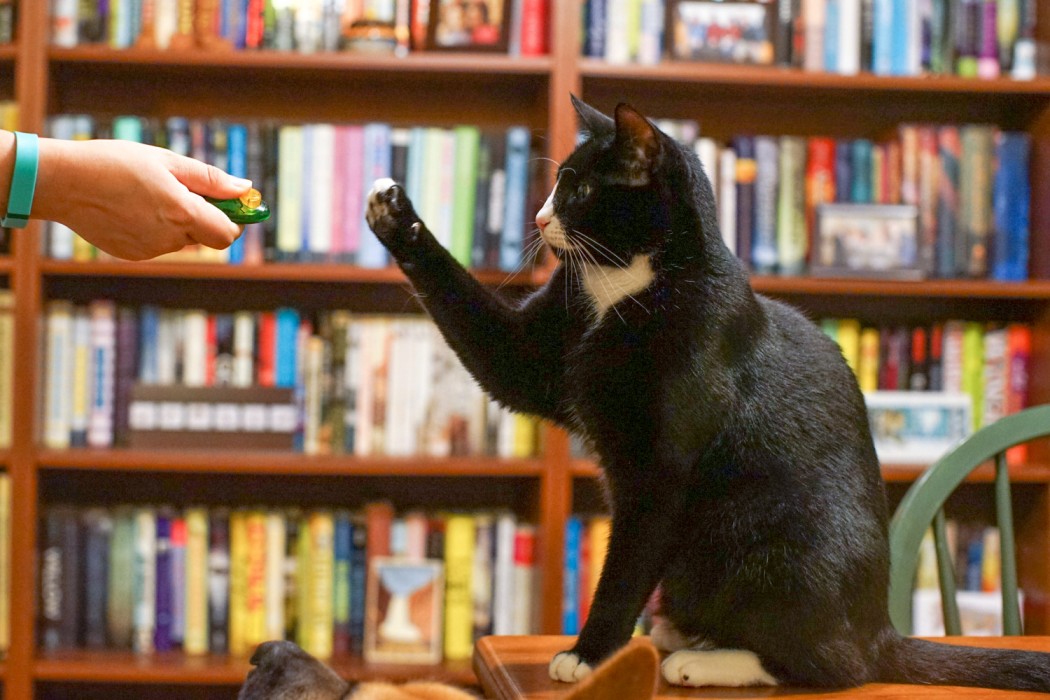You may have attempted to train a cat before. Perhaps you used the same stern “no” you used to scold your puppy, or maybe you squirted your kitty with a water pistol when she scratched the corner of the couch. It’s likely your cat didn’t even acknowledge the “no” that made your dog tuck his tail between his legs, and your cat probably still scratches the furniture (only now she knows not to do it in front of you).
Though they don’t respond to punishment, cats can be trained through learning that their behaviors have consequences, a concept known as operant conditioning. One of the most effective methods is done through positive reinforcement and is called clicker training.
Why clicker train a cat?
If you’re going to be heading into the great outdoors with your feline friend, it’s best to be prepared for anything.
What if a sudden noise or an excited off-leash dog spooks your kitty and she bolts? What if she slips out of her harness or darts out of the tent? You’ll sleep a little easier under the stars if you can trust your cat to respond to commands you’ve practiced.
Clicker training also has numerous other benefits.
Such training stimulates a cat’s mind, which can aid in correcting behavioral issues that stem from boredom. Also, as a form of exercise, clicker training can be good for your pet’s health.
It’s also a wonderful way to engage with your kitty and strengthen your bond. And it can be a lot of fun.
Learn more about clicker training from Best Friend Animal Society’s Dr. Frank in the video below.
Cats aren’t dogs
Dogs are social animals that we bred to fit our needs over hundreds of years, but cats are autonomous creatures that essentially domesticated themselves. Back when we started farming, cats moved in to feed off the rodents attracted to the crops. In other words, they came for the food and stuck around because the perks were good.
“Historically speaking, cats, unlike dogs, have not been domesticated to obey humans’ orders,” Atsuko Saito and Kazutaka Shinozukain write in “Animal Cognition.”
In fact, after 9,000 years of living alongside us, scientists have concluded that cats remain only semi-domesticated.
So if your cat isn’t going to work simply to please you, you’ll have to make training worthwhile.
 What you’ll need
What you’ll need
- A clicker (a small device with a metal strip that makes a clicking sound) or a clicker app
- *For deaf cats, use a penlight or flashlight in place of a clicker.
- Some treats or food your kitty enjoys
- Optional: a target stick (or the chopstick or wooden stick equivalent)
Charge the clicker
First, you’ll need to help your cat establish a connection between the sound of the clicker and a tasty treat, so when you have your kitty’s attention, click the clicker and immediately reward your cat with a small treat or a bite of yummy canned food. This reinforces the positive consequences of the desired behavior.
Some cats may immediately make the connection between the clicking sound and the treat, but you may need to repeat this process several times for your kitty. After all, cats learn from repetition just like we do.
Once your cat makes the association, you’ve successfully charged the clicker and it’s time to start working on some behaviors.
What’s next?
 You may want to teach your cat to come to the sound of the clicker, which will be helpful in beginning a training session or if you intend to bring the clicker on outings with your adventure cat. For more information on this, learn how to teach your cat to come when called.
You may want to teach your cat to come to the sound of the clicker, which will be helpful in beginning a training session or if you intend to bring the clicker on outings with your adventure cat. For more information on this, learn how to teach your cat to come when called.
If you’re using a target stick or something similar, the next step is to teach your cat to follow the target.
You can do this by placing the target close to your cat’s nose, and when he sniffs it, immediately click and reward the behavior. You can also put a bit of wet food at the end of the target stick to help get your cat’s attention.
Next, move the target next to your kitty, so he’ll have to turn in order to sniff it. Again, click and reward. Continue this process, moving the target farther away each time, until your cat is following the target.
Teach your cat to sit
 Dogs aren’t the only ones who can follow voice commands. Once you’ve charged the clicker, you can teach your cat to sit with or without a target stick.
Dogs aren’t the only ones who can follow voice commands. Once you’ve charged the clicker, you can teach your cat to sit with or without a target stick.
If you’re working with a target that your cat has learned to follow, hold it above his head and say “sit.” If you’re not using one, simply move the treat or spoonful of delicious kitty food slowly over the animal’s head and say the command.
With his nose pointed toward the treat or target, your cat should naturally move into a sitting position. As soon as his rump nears the floor or surface you’re working on, click to indicate the desired behavior.
Oh, the tricks your kitty could learn!
Once you’ve mastered the basics of clicker training, you can teach your cat a variety of behaviors, and you may reach a point where you no longer even need the clicker and your cat simply responds to vocal commands. However, just because you can teach your cat certain tricks, doesn’t necessarily mean you should.
Here at Adventure Cats, we love what cat behaviorist Jackson Galaxy calls the “raw cat” and we think we should preserve what makes a cat a cat.
“I love clicker training for cats … but once we get to the point where cats are performing tricks for humans it’s just so demeaning to the animal,” Galaxy says in a video. “Animals deserve the same amount of dignity that humans do. At the end of the day, there are 90+ million cats in homes in the United States for a reason: We love them. And we don’t love them because they act like dogs, and we don’t love them because they act like children. I hope we have them in our homes because they act like cats.”
Clicker training tips
- Keep training sessions to no more than a few minutes at a time.
- Click at the right moment to indicate the desired behavior.
- When you begin teaching your cat something new, start small and reward him for steps he makes along the way. For example, if you want to teach your cat to enter his carrier before you head out for a hike, begin by rewarding him for moving toward the carrier, then for standing next to it and finally for entering it.
- Don’t click more than once to indicated a desired behavior. Multiple clicks can be confusing.
- Don’t try to push your cat into the desired position or move him where you want him to go. Your cat’s movements should always be voluntary.
- Never punish your cat. Cats don’t respond to discipline, but they do respond to being rewarded for desirable behavior. Punishing a cat can actually backfire, causing a cat to become stressed or frightened and leading to behavioral problems.
For more information on clicker training, visit the ASPCA or Best Friends Animal Society.
All photos: Cody Wellons





